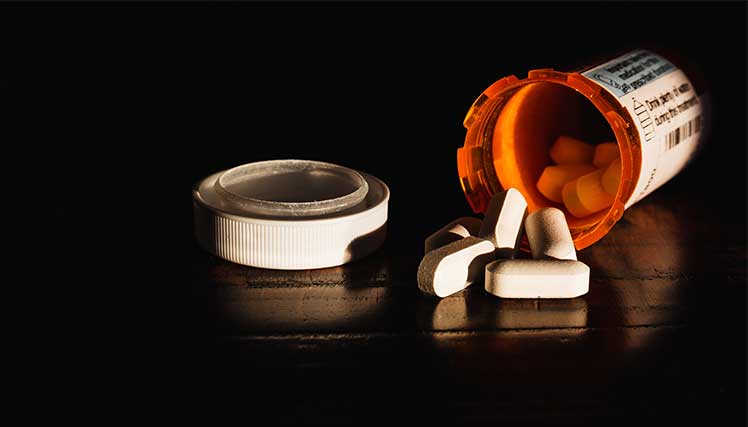Opioid Addiction | Opioids In Ohio

Medically Reviewed By: Kimberly Langdon, M.D.
While the ongoing opioid epidemic continues to affect Ohioans, opioid addiction treatment options are available in Ohio.

Opioid addiction is a serious mental health condition defined by an inability to stop taking opioid drugs, despite ongoing health effects. It may also be called opioid use disorder by addiction medicine professionals.
Opioid addiction can outweigh the short-term effects of chronic pain relief. In the long-term, it can lead to health effects such as respiratory depression, gastrointestinal issues, cardiovascular failure, and a decline in mental health. Some of these effects may be visible to others.
In 2021, 3 million United States citizens met the criteria for a past or present opioid use disorder (OUD). While the ongoing opioid epidemic continues to affect millions of Americans, evidence-based treatment and counseling can help patients overcome OUD.
Definition Of Opioid Addiction
Opioid addiction is a mental health disorder defined by an inability to stop taking opioids. The term opioid use disorder, used in place of opioid addiction, may encompass physical dependence and withdrawal symptoms as well as addiction, as opposed to only the mental health aspect of addiction.
Opioids are potent substances that have seen heavy use in the United States for decades.
Hydrocodone, oxycodone, codeine, and fentanyl are some examples of opioid painkillers approved as prescription drugs. Prescription opioids can cause severe tolerance and dependency by changing how opioid receptors work in your brain.
A person suffering from an opioid use disorder may be aware that opioids are detrimental to their health. However, this awareness may not outweigh the opioid cravings they experience, or the pleasant effects that result from opioid abuse.
Effects Of Opioid Addiction
Long-term opioid use has been linked to several long-term health effects. These effects vary widely and may affect many different bodily systems, and can include:
- weakened immune system
- weakened bone structure
- major depression
- cardiovascular failure
- sleep apnea
- bowel obstruction
Taking opioids can also cause short-term side effects, such as drowsiness, constipation, and impairment. You may experience these side effects every time you take opioids.
Learn more about the Side Effects Of Opioid Use
Opioid Overdose In Ohio
Opioid addiction can be a risk factor for opioid overdose, as higher doses of opioids may be ingested on a regular basis. Opioid overdose can be life-threatening without proper treatment, as it can cause hypotension, slowed heart rate, and slowed or stopped breathing.
Naloxone may be given to drug overdose victims who ingested opioids. Naloxone binds to the same receptors as opioid drugs, and can reverse the life-threatening effects of an overdose. Naloxone may be given by civilians without intensive medical training.
After a patient successfully recovers from an opioid overdose, they may be recommended for long-term treatment.
Learn more about Opioid Overdose
Signs Of Opioid Addiction
Addiction can cause a person to prioritize drug use over other essential aspects of their daily life. Over time, it can become difficult for a person to hide a drug addiction.
Signs of an opioid addiction in a family member or loved one may include:
- prioritizing opioid use over important activities, such as working or attending school
- a need for increased opioid dosage
- changes in social circles
- declining physical and mental health
- presence of drug paraphernalia
- displaying opioid withdrawal symptoms
These signs may mean that a person close to you is struggling with a substance use disorder, and may benefit from an intervention and professional help.
Risk Factors Of Opioid Addiction
Some demographics may be at a higher risk of opioid use disorders than others. An opioid dosage that may be safe for one person can be habit-forming for another.
Patients with a history of substance abuse may be more likely to abuse opioids as well. Patients with preexisting mental health conditions, such as depression or a history of trauma, may also seek the analgesic and numbing effects of opioid medications.
Other risk factors include a poor socioeconomic standing and taking drugs from a young age. Patients may inform their doctor of their medical and personal history before an opioid prescribing schedule begins.
Opioid Addiction Treatment Options In Ohio
Opioid addiction and overdose deaths continue to be a concern in the United States, prompting research into long-term opioid addiction treatment.
In 2022, there are evidence-based opioid treatment programs you can be referred to through your healthcare provider, or through online resources.
Medical Detox
Opioid addiction treatment programs may begin with a detoxification, or detox, where opiates are flushed out of your system. You may receive medical supervision at a treatment center during the detox process, as you may need withdrawal management and pain relief services.
Medication-Assisted Treatment
After a successful detox, you may be recommended for medication-assisted treatment, or MAT.
MAT is an evidence-based treatment that may use methadone and buprenorphine to reduce opioid cravings. These medications may be given under supervision and have comparatively low abuse potentials.
Other Treatment Services
Other treatment options may involve behavioral therapy, referrals to support groups, and aftercare planning.
To find out if our residential opioid treatment program works for you or a loved one, please contact us today.
FAQs
What Are Some Of The Strongest Opioids?
One of the strongest opioids is heroin. Because it’s so addictive, it’s only available on the illegal drug market.
Fentanyl is even more powerful, being up to 50 stronger than heroin and 100 times stronger than morphine. It’s been linked to numerous drug overdose deaths.
The most powerful opioid is carfentanil. It’s 10,000 times stronger than morphine and 100 times stronger than fentanyl. Since it’s so powerful, it’s never prescribed for humans. Instead, it’s used to sedate elephants and other large animals.
Learn more about Opioids By Brand Name & Street Name
How Long Do Opioids Stay In Your System?
How long opioids stay in your system depends on a number of factors including the half-life of the specific drug, your body weight, your age, and your overall health.
Learn more about How Long Opioids Stay In Your System
What Do Prescription Opioids Look Like?
Prescription opioids come in a wide variety of forms including pills, syrups, injections, suppositories, nasal sprays, and lozenges.
Learn more about What Prescription Opioids Look Like
How Much Do Opioids Cost?
How much opioids cost depends on a variety of factors including whether you’re using prescription opioids from a doctor or illicit opioids from the street. It can also depend on whether you have insurance or not as well as the type of opioid you’re buying.
Learn more about The Cost Of Opioids
What Do Opioids Feel Like?
Opioids, whether illicit or prescribed, can create side effects such as euphoric feelings, a release of inhibitions, and sedation. Opioid effects may consist of extreme relaxation but can lead to life-threatening health concerns when abused.
Learn more about What Opioids Feel Like
Are Opioids Narcotics?
Per the CDC, opioids are strictly considered narcotics to avoid being confused with certain illegal drugs.
Learn more about Opioids As Narcotics
- Anesthesia and Analgesia - Risk Factors for Opioid-Use Disorder and Overdose https://journals.lww.com/anesthesia-analgesia/fulltext/2017/11000/risk_factors_for_opioid_use_disorder_and_overdose.41.aspx
- National Institute on Drug Abuse - Opioids https://nida.nih.gov/drug-topics/opioids
- National Library of Medicine: StatPearls - Opioid Addiction https://www.ncbi.nlm.nih.gov/books/NBK448203/
- The Primary Care Companion for CNS Disorders - Review of Potential Adverse Effects of Long-Term Opioid Therapy: A Practitioner's Guide https://www.ncbi.nlm.nih.gov/pmc/articles/PMC3466038/
- Substance Abuse and Mental Health Services Administration - Treatment and Prevention Strategies to Reduce Opioid Misuse https://www.samhsa.gov/blog/treatment-prevention-strategies-reduce-opioid-misuse

